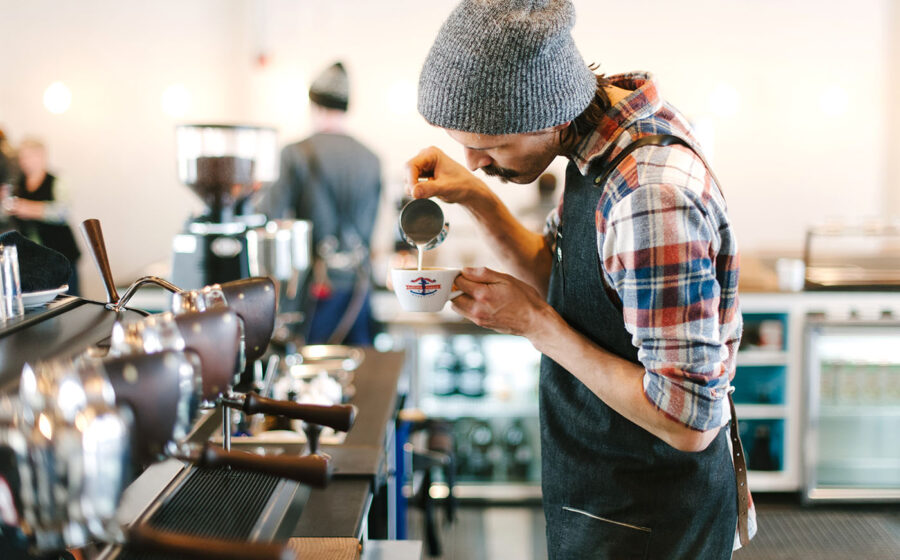[W]hen Andy Mumma was a barista, he often hated the bar spaces he worked in. Many hid the baristas behind a wall of espresso machines and grinders, cramming them in a corner, surrounding them with to-go cups and syrup bottles. It created a barrier that divided the customers from the baristas and made quality interactions impossible. It also made for bad barista work. A hidden barista, Mumma found, had a messy station and often careless preparations.
“I knew that if I ever got the chance to have my own place, I definitely wanted it to look different and I wanted it to flow differently. I wanted people to open their minds and have a different experience, to showcase the baristas more and the coffee and what we do,” Mumma says. “It makes you really aware of your station and makes you work clean and efficient.”
That ethos showed up in his first café, which opened in 2011, but his recently opened second shop in Nashville takes that open design to an extreme and then adds a level of symmetry that Wes Anderson would find compulsive.
Built in the erstwhile Golden Sound recording studio, Barista Parlor at Golden Sound has plenty of floor space to play with and Mumma put the bar in the center, an increasingly common design decision in mid-sized cities. His bar, though, isn’t an island. It’s a square archipelago made up of an island for ordering and pastry displays, two parallel espresso bars, and long brew bar. The lagoon between the islands has enough space to let a cashier walk to the dual pour-over stations without disturbing the mirrored baristas.
Out in the open like this, where in spots a barista can be viewed head-to-toe, the entire process is exposed, turning the bar into something like a stage. Mumma says he enjoys this performance aspect of the space. “This setup is not for everyone. It’s not for that part-time, in school, just whatever coffee gig. You definitely need to use a different part of your brain than you do when the bar flow is just speed, speed, speed. Obviously you work as fast as you can, but the way you work, the way you line up drinks, the way you set up everything, everything is part of the complete flow here,” he says. “It’s certainly not a bad place to work if you wanted to get into competitions.”
The huge space will house more than a café. Next year, Mumma will begin roasting. The café’s multi-roaster model will remain, with Barista Parlor’s beans joining some of the best roasts in the country.

1. The Symmetry: Andy Mumma, Barista Parlor’s owner, says the symmetrical layout is for flow and efficiency. He also says each space he designs “is about my OCD.”
2. Under the Skin: The Golden Sound café has a red, white, and blue (think Speed Racer) color palette. As this espresso machine takes its inevitable dings and scratches, each blemish will show as red under the black powder coat. The other machine will show blue.
3. Custom Islands: With customers able to see into the bar, there’s no way a bus tub or garbage bin can go on the floor. Spaces for tubs and trash are built into the bar. Even scales are hidden away in cutouts on top of the bars. The blue boxes are tool chests with all the gear to keep the machines in order.
4. Dueling Pour-overs: Clive Coffee’s V60 stands do most of the pour-over work, but Chemex, Solo, and nel drip are available as well.
5. Post-it Notes: Every order goes on a sticky note and is sent to the espresso or brew stations.
6. Towers of Cold Brew: Eight Yama cold-brew towers, divided in mirrored sets of four, naturally, produce coffee kept in growlers in the far fridges.
7. CO2: Hoses attached to CO2 tanks are also hidden in the bar, ready to charge signature drinks and then go out of sight.
8. Slayer, Redux: The second espresso machine usually shuts down after the lunch rush. After that, it’s used for training and once the roastery is operational it will be used on trials of new roasts.
—Cory Eldridge is the editor of Fresh Cup.










